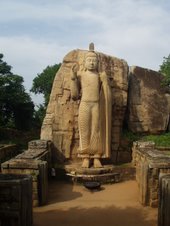
This is the lead elephant of the perehera. It would probably be a very old and venerable creature that has been designated the task of being the perehera elephant for many years. In this particular perehera, the elephant does not carry a dhatu or religious artifact, but in the esala perehera which happens in may, the elephant carries the holy tooth relic mentioned below. This particular elephant went for a huge crap and wee (it looked like someone was hosing down the path, but you wouldn't want to step in it). He also inhaled a 'snack' of an entire hand of bananas as we might eat a single lolly.

The procession was a distinctively Singhala affair - since it is primarilly Buddhist - and only provided images and costumes associated with Singhala legend. Consequently, there were several groups of flag bearers that bore the image of the Sri Lankan flag. The Singhalese are quite natioanlistic, so this is not particularly odd. See previoius posts for an analysis of the meaning behind the flag.

According to Sri lankan legend, the Singhala people were a product of the copulation between a god and a lion. The lion (singhaya) is therefore an important animal in within the Singhala psychological scehma. As far as I know, however, lions are not native to Sri Lanka and I don't believe that any actually live there, so the origins of the myth remain a mystery to me. In any case, a lot of Sri Lankan art involves images and designs of lions and they are common guardian figures at important Buddhist sites.

Perhaps the most popular god worshipped by the Singhalese is Katuragama (a town is also named after him. Katuragama is the Hindu war god Skandha and he has risen in importance over the last fifty years to replace the official guardian of Sri Lanka, Vishnu. Katuragama's vehicle is always the peacock - another important Sri Lankan animal (it features on 1000 rupee notes) along with the snake. These dancers above are therefore implying Katuragama, although having an image of Katuragama in a Buddhist parade might be religiously confusing for the onlookers.

Another important god in Sri Lankan lengend is Hanuman, the monkey god. He is generally regarded as mischievious individual and his moral worth in the eyes of Sri Lankans is unclear to me (for example, Katuragama is regarded as morally impure, but he is nonetheless highly respected). The story is that Hanuman fled India with a kidnapped bride and escaped to Sri Lanka. He managed this by jumping across the strait with his powerful legs arriving in what is now known as Bandarawella. There he kept the bride imprisoned for many years causing grief to the ruler in India. The story is told the same way in India.

These people are all stilt-walkers. As far as I can tell, there are no distinctive cultural implications involved with this - its just a bit of fun. However, it looked rather uncomfortable even though the people were having a lot of fun!

No comments:
Post a Comment